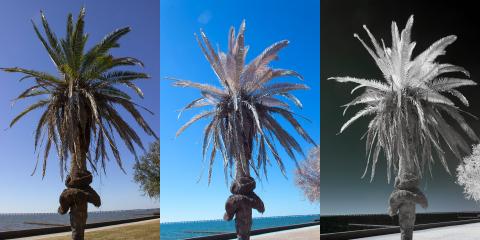 This is a quick cross-post of a short article written for my photography website, explaining false-color infrared photo production.
This is a quick cross-post of a short article written for my photography website, explaining false-color infrared photo production.
The term "infrared" when applied to photography might make one think of the type of "thermal vision" or "night vision" popularized by movies, but the reality is somehow both more and less dramatic. In the world of art photography, an infrared photograph differentiates itself from typical digital or film photography by way of revealing light that we, as humans, can not see through other means. This light is then interpreted by the artist from something invisible to something that is not quite real.
Specifically, in today's modern digital world, IR photographs use special camera hardware equipped to capture the entire spectrum of light. Most digital cameras are built to explicitly block many long wavelengths of light beyond our visible red in an effort to keep captured images as accurate as possible to what the human eye can see; cameras intended for use in IR photography lack this filter and are described as "full-spectrum cameras" due to their ability to, by default, capture light that we can't perceive beyond both ends of the visible spectrum.
The artist composes their photographs using a selection of filters to select the exact wavelengths of infrared light that will make it to the camera sensor. Typically, the wavelengths used will range between 720 and 900 nanometers, with the effect of the photo changing as do the wavelength selections. Once captured, the photos will look, predictably, quite red to the human eye. The filter and camera serve to represent the image in a manner that humans can see - of course, to do otherwise would have no point. To create an image more aesthetically pleasing, the artist must then adjust the image to present the colors that we can not see in a manner that we can; this false-color photographic method is what gives IR photography the surreal or dreamy qualities for which it is known.
Some might consider this style of photography to be just another application of Photoshop, but to make this assumption is to undersell the power of the underlying light. Indeed, no photo-editing software can be used to reproduce the effects of a well-taken infrared photograph. It is simply impossible to use visible light to emulate the effect of light that we can not see, and the use of photo editing software in IR photography is only to make the conversion from the invisible to the visible.
- Log in to post comments